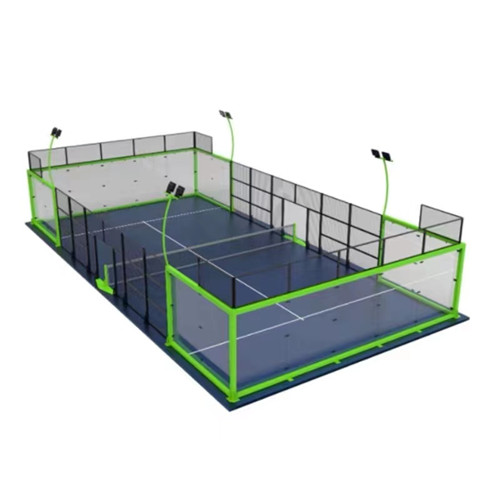What is padel and why is it so popular?
Padel (padel/cage tennis) is a ball game that blends elements of tennis, squash, and table tennis. Played in a doubles format in an enclosed court, it has rapidly gained global popularity due to its accessible, social, accessible, and fun nature. The following is a detailed analysis of its core features and the reasons for its popularity:

I. Padel Core Features
Venue and Rules
Enclosed courts: Approximately one-third the size of a tennis court (20 meters long x 10 meters wide), surrounded by glass walls and metal mesh. The ball can bounce off the walls and then be hit, increasing tactical diversity.
Doubles: Typically played in a 2-on-2 format, it emphasizes teamwork and interaction.
Simplified Rules: The serve requires a groundstroke, and the ball must be hit after landing once (similar to tennis), but allows for a single bounce before being caught, lowering the skill barrier.
Equipment and Rackets
Rackets: Stringless, made of foam or rubber, with perforated face to reduce wind resistance and a short handle for easier control. Ball: Similar to tennis, but with lower air pressure and slower speed, making it more suitable for beginners.
Sports Intensity
Low Impact: No extensive running or forceful hitting is required, making it suitable for all ages, including children, middle-aged adults, and the elderly.
Full-Body Exercise: While the intensity is lower, it still requires coordination, flexibility, and endurance, and long-term participation can improve physical fitness.
II. Five Reasons for Padel's Popularity
Ease of Use
Quick Start: Beginners can play in just a few hours of training, significantly faster than with traditional sports like tennis.
Technical Inclusivity: Allowing the ball to bounce off the wall reduces the need for precise shots and reduces frustration.
Social Aspects
Doubles: Naturally promotes teamwork and communication, making it ideal for gatherings with friends or family events.
Venue Design: Glass walls bring spectators closer to the players, enhancing interaction and creating a lively social atmosphere.
Celebrity Effect: Celebrities such as Messi, Beckham, and Nadal have participated, making padel a new trend in high-end social circles. Low Barrier and Universal Access
Age Inclusiveness: No exceptional strength or physical fitness is required, making it suitable for all ages and even suitable for rehabilitation training.
Gender Equality: Mixed doubles is common, promoting gender equality and interaction.
Fun and Tactical
Glass Wall Bounce: A variety of ball paths create uncertainty and enhance the viewing experience.
Tactical Depth: Combining the baseline rallies of tennis with the near-net volleys of squash, it requires flexible use of court space.
Commercial Promotion and Globalization
Professional Tournament System: Events such as the World Padel Tour and the Premier Padel Tour attract top players and enhance the sport's influence.
Emerging Market Presence: Countries like the United States and China are accelerating the construction of padel courts and leveraging social media marketing to expand their user base.
Brand Partnerships: Brands like Nike and adidas are launching exclusive equipment to further promote commercialization.
III. Global Data and Trends
Number of Players: Over 25 million players worldwide, with an annual growth rate exceeding 30%, making it one of the fastest-growing sports.
Market Presence: High penetration rates are seen in countries like Spain, Argentina, and Mexico, while emerging markets like the United States and China are experiencing rapid expansion. Strengthening social attributes: New York luxury homes are building private padel courts, positioning them as high-end social venues.
IV. Comparison between Padel and Tennis
Dimensions: Padel Tennis
Court Size: 1/3 tennis court, enclosed by glass walls
Standard open court
Participants: Mainly doubles
Singles/doubles
Skill Level: Low, ball bounces
High, requires precise hitting and running
Social Attribute: Strong, close interaction between spectators and players
Weak, spectators are further away
Sports Intensity: Low to Medium
Medium to High
V. Conclusion
The popularity of padel is fundamentally a revolution in the sports experience: by simplifying rules, enhancing social interaction, and lowering barriers to entry, it transforms the competitive nature of traditional tennis into an accessible and entertaining sport for all. With global promotion and the influx of commercial capital, padel is moving from a niche trend to a mainstream sport, potentially becoming a new benchmark for urban leisure sports.
padel court,Gymnastic mats, basketball racks, volleyball posts, tennis dwellings, badminton posts, adult gymnastic equipment, parallel bars, horizontal bars, uneven bars, gymnastic rings, balance beams, saddles, hydraulic referee tables, table tennis tables, outdoor fitness equipment, garden fitness equipment
Website:
http://www.hransports.com/faq/297.html